 |
Picks is a monthly sampling of Japan's art scene, offering commentary by a variety of reviewers about exhibitions at museums and galleries in recent weeks, with an emphasis on contemporary art by young artists. |
 |
 |
 |
1 November 2012 |
 |
| 1 | 2 | |
 |
|
 |
 |
|
|
 |
 |
|
| Yuichi Takahashi |
| 7 September - 21 October 2012 |
The National Museum of Modern Art, Kyoto
(Kyoto) |
 |
| Many Japanese view Takahashi (1828-94) as a curiosity, the former samurai who became enamored of Western art and did an oil painting of tofu, of all things. But the gritty realism of his technique, of which Tofu is an eloquent example, is as different from today's notion of realism as the sense of touch is from the sense of sight. This recent show offered not only signature works like Salmon and Courtesan, but also illustrations of animals and plants that Takahashi drew while attending the Kaiseijo, the institute of Western learning set up by the Shogunate in its waning years. |
|
|
 |
 |
 |
|
| Mami Fukumura |
| 11 - 23 September 2012 |
gallery morning kyoto
(Kyoto) |
 |
| Using a mix of oils and acrylics, Fukumura paints what she calls "scenes embedded in memory." In this exhibition of new works she continued to focus on bodies of water -- pools, ponds, fountains -- and the play of wind, light, and reflections across their surfaces. Such is the richness of expression therein that one never tires of viewing these works. This latest show also included a few small monotype prints, which are equally refreshing to look at. |
|
|

|
 |
 |
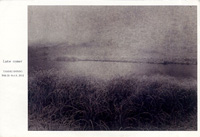 |
 |
| Tamaki Shindo: Late comer |
| 20 September - 8 October 2012 |
hpgrp Gallery Tokyo
(Tokyo) |
 |
| Through a process of repeated cutting, pasting, and color-copying of photographs she has taken, Shindo creates "landscapes" that exude a mysterious magnetism. In this solo show the ratio of monochrome prints seemed to have increased, as well as that of strongly pictorial elements. One senses that the artist is driven by a powerful expressive impulse to pose new challenges for herself. |
|
|
 |
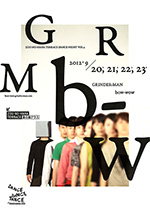 |
 |
| Grinder-Man: bow-wow |
|
|
Zou-no-Hana Terrace
(Kanagawa)
|
 |
| Known until now for edgy performances that involved churning grinders and showers of sparks, the Grinder-Man group has gone through some changes, it appears. They now start by directing the audience to "act in accordance with the prevailing mood" -- i.e., if a performer runs to the right, chase after him; if yanked out of your seat by a performer, follow along. While the movements of the group have a certain cohesion they lacked before, they can hardly be said to be dancing, and a sense of freedom is missing. They may still need to go through a few more changes. |
|
|
|
|
|
|
|

|
 |
 |
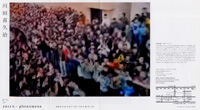 |
 |
| Kikuji Kawada: 2011 - phenomena |
| 4 September - 31 October 2012 |
Photo Gallery International
(Tokyo) |
 |
| Since his seventies series Los Caprichos, a recurring theme of Kawada's work has been his attempt to expose through snapshots the angst that lies just beneath the veneers of contemporary society. In 2011 - phenomena he raises the stakes further with garishly colored montages of iterations of still photos and TV images. The faces of such figures as Barack Obama, Hillary Clinton, and Osama Bin Laden rupture, morph, and propagate. Kawada proves that his antennae are as sharply tuned as ever to the nightmares lurking behind the quotidian world. |
|
|
 |
 |
| Koji Enokura: Documentation |
| 4 - 29 September 2012 |
Taka Ishii Gallery
(Tokyo) |
 |
| A member of the Mono-ha movement, Enokura (1942-95) was fascinated with photography and scrupulously documented his installations on film. This exhibition brought together prints of the photos he took of his work from 1969's Ceremony of Walking to 1976's Indefinite Field. Among them are numerous images of works that would later be deemed his masterpieces, such as Quality of Wetness and Wall, which he submitted to the 1971 Septième Biennale de Paris. |
|

|
 |
 |
 |
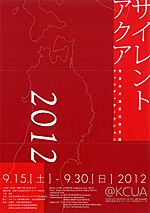 |
|
| Silent @KCUA 2012 |
| 15 - 30 September 2012 |
Kyoto City University of Arts Gallery @KCUA
(Kyoto) |
 |
| This charity auction for victims of the Tohoku earthquake and tsunami of 2011 peddled artworks contributed by students, graduates, and faculty (both active and retired) of the Kyoto City University of Arts. Held at the school's Gallery @KCUA (pronounced Aqua), this was the second such event. One of the auction's charms was that it made purchaser-friendliness a priority by requiring that donated works be postcard-size and by starting the bidding at a low 3,000 yen (US$38). Artist names were hidden, so bidders didn't know whose works they were getting until they'd sealed the deal. Part of the fun, then, was bidding for work just because you like it, without any preconceptions. |
|
|
 |
 |
 |
| Chim Pom |
| 22 September - 14 October 2012 |
Parco Museum
(Tokyo) |
 |
| Currently on a roll of art-world adulation, Japan's favorite Dada-pranksters managed to score a gig at Shibuya's upscale Parco department store. Though it included works they have already shown overseas, made of garbage, exhaust gas and the like, it was the chutzpah with which the group took over this particular venue that made this show so entertaining. For example, they removed the letters P and C from the store's massive outdoor logo and moved them indoors (where they installed them in the order C-P, of course); they also recreated one of the store's boutiques and plastered it with drawings. Outside the store entrance sat a massive stuffed trash bag, which they encouraged passersby to bounce on, like a trampoline.
|
|
|
|
|
|
|
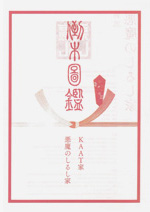 |
 |
| Akuma no Shirushi: Illustrated Guide to Fallen Trees |
| 27 - 30 September 2012 |
Kanagawa Arts Theatre
(Kanagawa) |
 |
| The brainchild of enfant terrible and avowed heavy-metal fan Noriyuki Kiguchi, the theater troupe Akuma no Shirushi is named after his favorite tune, "Symptom of the Universe" by Black Sabbath (though the Japanese title actually translates as "Sign of the Devil"). Kiguchi is an architecture-school graduate, and indeed this piece at KAAT shows an architect's influence, both in staging and story. Its skewed take on the uses of buildings and its wedding/funeral format are novel, but the plot lacks punch, with episodes and references that are a bit too in-jokey. A slightly less chaotic and more universalized approach might be in order. |
|
 |
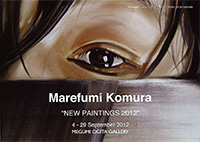 |
 |
| Marefumi Komura: New Paintings 2012 |
| 4 - 29 September 2012 |
Megumi Ogita Gallery
(Tokyo) |
 |
| Known for the thick, intense brushwork of his portraits, Komura here places realistic figures and abstract brushstrokes at odds with each other, erasing the face and hoofs of a horse, or slashing a smear of paint across a young boy's eye. The works thus begin to take on aspects of film or video. The breadth of his expressive palette continues to grow, with motifs veering from sixties TV superheroes like Ultra Seven and the Masked Rider to images blurred by the brush in the manner of Gerhard Richter. |
|
|
|
|
 |
|